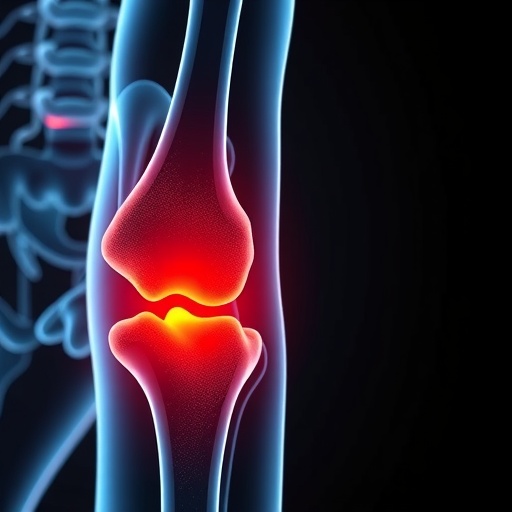In a remarkable breakthrough that could redefine the therapeutic landscape for osteoarthritis (OA), researchers have identified the pivotal role of VGLL4 in maintaining extracellular matrix homeostasis in joint tissues. This discovery not only sheds light on the molecular underpinnings of OA but also opens promising new avenues for interventions that could halt or even reverse the debilitating progression of this chronic disease—a condition that currently affects hundreds of millions globally.
Osteoarthritis is characterized by the degeneration of articular cartilage and remodeling of the periarticular bone, culminating in pain, stiffness, and reduced mobility. Despite its prevalence, the molecular mechanisms orchestrating the interplay between cartilage degradation, extracellular matrix (ECM) disorganization, and joint inflammation have remained elusive. The study conducted by Suo et al. unveils that VGLL4, a transcriptional cofactor previously understudied in joint biology, serves as a critical guardian of ECM integrity.
The extracellular matrix, a complex network of proteins such as collagens, proteoglycans, and glycoproteins, provides structural and biochemical support to surrounding cells. Its homeostasis is crucial for maintaining joint function. Dysregulation of ECM components leads to compromised cartilage resilience, instrumental in OA pathogenesis. Suo and colleagues demonstrated that VGLL4 exerts its effects by orchestrating gene expression programs that preserve ECM protein balance and prevent inflammatory cascades typically seen in osteoarthritic joints.
Using a meticulous preclinical model mimicking human OA, the researchers employed sophisticated genetic and pharmacological tools to manipulate VGLL4 activity. Remarkably, enhancing VGLL4 expression forestalled ECM deterioration and remarkably mitigated hallmark features of osteoarthritis, including cartilage erosion and synovial inflammation. This strongly suggests that VGLL4 is not simply a passive marker but an active modulator capable of restoring and maintaining joint tissue quality.
At a molecular level, the team elucidated the downstream signaling pathways associated with VGLL4, highlighting its interaction with the Hippo-YAP pathway—a critical nexus for cellular proliferation and apoptosis in various tissues. VGLL4 modulates transcriptional landscapes that govern matrix metalloproteinase activity and cytokine production, both central perpetrators in ECM destruction and chronic inflammation. By rebalancing these molecular networks, VGLL4 essentially acts as a molecular check against pathological remodeling.
Notably, VGLL4’s modulatory capacity extended beyond chondrocytes to influence multiple cell types residing within the joint microenvironment. This multidimensional property addresses the urgent need for therapies that target OA as a multifaceted disease rather than a single-cell dysfunction. The ability of VGLL4 to maintain ECM homeostasis and suppress inflammation concurrently represents a paradigm shift in our approach to degenerative joint diseases.
Their findings also highlight potential therapeutic strategies whereby synthetic VGLL4 agonists or gene therapy approaches could be employed to deliver sustained benefits in osteoarthritis patients. Given the current limitations of symptom-focused treatments and invasive surgeries, a platform targeting VGLL4 offers hope for disease-modifying therapies. The data provided compelling evidence of improvement in pain and joint function metrics, underscoring translational relevance.
Importantly, this research aligns with growing interest in the Hippo pathway’s involvement in tissue regeneration and fibrosis. VGLL4 emerges as a crucial molecular node whose pharmacological targeting might not only address OA but also other ECM-related pathologies characterized by aberrant tissue remodeling. Future investigations will explore VGLL4’s therapeutic utility across diverse degenerative conditions, broadening its clinical impact.
This comprehensive study also employed state-of-the-art imaging and biomechanical assessments to validate the structural and functional integrity of treated joints. These quantitative approaches corroborated histological findings, confirming that VGLL4-centered interventions enhanced cartilage thickness, reduced osteophyte formation, and preserved biomechanical resilience.
Another significant aspect was the elucidation of VGLL4’s regulation under physiological versus pathophysiological conditions. The researchers documented a substantial downregulation of VGLL4 in osteoarthritic tissues compared to healthy controls, implying that VGLL4 insufficiency contributes intrinsically to disease onset and progression. This insight highlights the potential of early intervention strategies aiming to restore VGLL4 expression.
The interdisciplinary collaboration evident in this work integrates molecular biology, bioinformatics, and preclinical modeling, embodying cutting-edge translational science. The researchers utilized transcriptomic and proteomic profiling to map the intricate regulatory networks downstream of VGLL4, providing a rich resource for future drug discovery and biomarker identification efforts.
Furthermore, this investigation underscores the therapeutic promise of targeting transcriptional cofactors rather than traditional extracellular or enzymatic targets. By influencing gene expression programs broadly and precisely, VGLL4-based therapies hold the potential for robust, sustained modulation of pathogenic processes with fewer off-target effects—an aspiration in precision medicine.
While challenges remain, including optimizing delivery systems and ensuring safety profiles in human subjects, the evidence presented marks a critical milestone. As OA continues its rise in incidence due to aging populations and lifestyle factors, innovative solutions such as VGLL4-targeted therapies will be indispensable in alleviating the burden on healthcare systems and improving quality of life.
Collectively, the findings by Suo et al. redefine our understanding of joint homeostasis and disease, demonstrating that VGLL4 is a master regulator of ECM dynamics with profound implications for osteoarthritis management. The translational potential of modulating VGLL4 activity advocates for urgent advancement toward clinical trials, signaling a hopeful horizon in the fight against this pervasive joint disorder.
The study’s implications extend beyond osteoarthritis, inviting exploration into VGLL4’s role in other connective tissue disorders and fibrotic diseases. Its ability to stabilize ECM and counteract inflammation could make it an attractive therapeutic target in conditions ranging from pulmonary fibrosis to cardiovascular remodeling, heralding a new class of biologics with wide-reaching benefits.
In conclusion, this pioneering research illuminates a novel molecular target—VGLL4—whose precise manipulation may revolutionize the treatment paradigm for osteoarthritis. As the scientific community rallies to translate these insights into effective therapeutics, patients worldwide stand to gain unprecedented relief from the relentless progression of joint degeneration, transforming lives through innovation at the molecular frontier.
Subject of Research: Osteoarthritis and extracellular matrix homeostasis modulation via VGLL4.
Article Title: Targeting VGLL4 maintains extracellular matrix homeostasis and mitigates osteoarthritis in a preclinical model.
Article References:
Suo, J., Wang, D., Wang, J. et al. Targeting VGLL4 maintains extracellular matrix homeostasis and mitigates osteoarthritis in a preclinical model. Nat Commun 16, 9325 (2025). https://doi.org/10.1038/s41467-025-64361-7
Image Credits: AI Generated
Tags: cartilage degradation and joint inflammationchronic disease affecting joint healthextracellular matrix homeostasis in jointsinterventions for osteoarthritis managementmolecular mechanisms of osteoarthritisnew therapies for joint healthpain and mobility in osteoarthritispreserving ECM integrity in osteoarthritistranscriptional cofactor VGLL4 in joint biologyunderstanding osteoarthritis pathogenesisVGLL4 and joint tissue protectionVGLL4 role in osteoarthritis treatment





